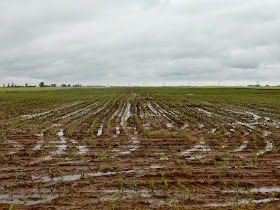 |
| Kim's County Line photo from April 2012 |
Instead, a whole lot of uncontrollable factors affect the 9-month life cycle of wheat.
 |
| Sunrise photos from May 19, 2015. Seeing the sun was short-lived on Tuesday. I think it lasted about 15 minutes at sunrise and then we didn't see it the rest of the day! |
 |
| The 2015 corn crop |
But, back to wheat: The 2015 Wheat Quality Council's Hard Red Winter Wheat tour traveled through Kansas earlier this month. Bushel per acre estimates for the tour were: Day 1, 34.3 bushels per acre; Day 2, 32.8 bu/acre; Day 3, 48.9 bu/acre. The 288.5 million bushel projection for the 2015 crop is higher than last year's tour prediction of 260 million bushels, but it's still below the state average.
Last year's actual production was 246.4 million bushels. The 2014 wheat crop suffered from severe drought stress due to lack of moisture throughout the growth stages and an overabundance of rain during harvest.
Ironically, heavy rains fell during much of the 2015 wheat tour. The 92 participants on the tour were getting their feet wet as they checked fields across the state, while still noting the short stature of the crop in many locations due to little moisture throughout the fall and winter.
Still, the rains did help with filling the wheat heads. And, at least around here, the plants also have grown taller after the spring rains, which should make it easier to combine in June.
There are other challenges to the 2015 crop, including stripe rust, wheat streak mosaic virus, barley yellow dwarf virus, winter kill and pest infestations such as aphids, according to Kansas Wheat. The moisture, at this stage, is a mixed blessing, since moisture increases disease pressure, especially in some wheat varieties.
We also have some wheat lying down in the fields because of the rain. As Randy says, the "upside" of that is that there is grain in the head. It happened last weekend, too, but with some sunshine and drying, it stood back up. We'll hope for the same outcome after this round of rain.
Yes, the 2015 crop is still a mystery. Just like any good "whodunit," we can have our theories about the ending. But, until we finish the last chapter, we won't have the answer.
For more on the Wheat Quality Tour, check out Kansas Wheat.




Your wheat crop is looking mighty stunning in that light of your photos. May it yield well for you.
ReplyDeleteThanks! The rain is helping the heads to fill, but we're now ready for some sunshine. (Are farmers ever happy?)
Delete